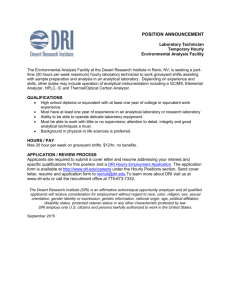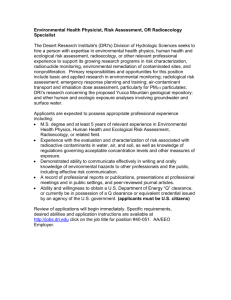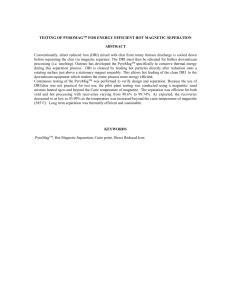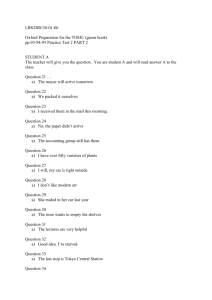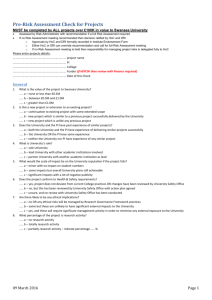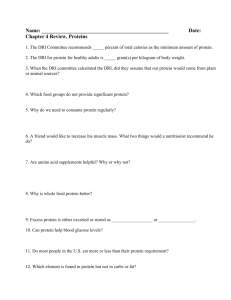Use of DRI in EAF’s Gregory L. Dressel Pawleys Island, SC, USA
advertisement
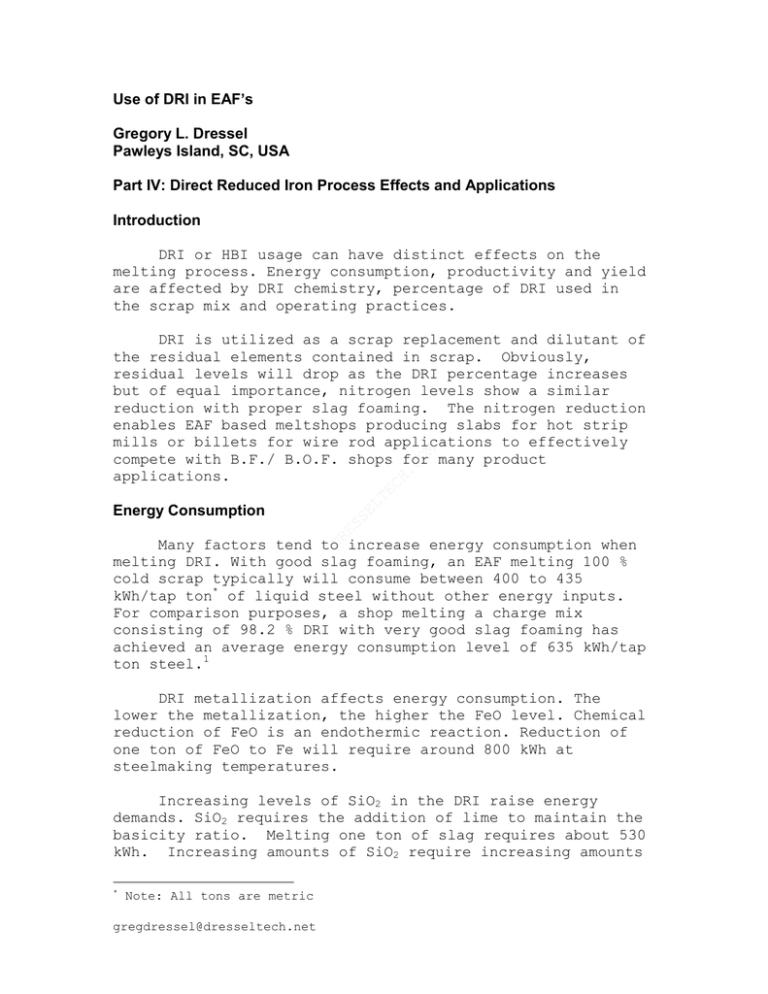
Use of DRI in EAF’s Gregory L. Dressel Pawleys Island, SC, USA Part IV: Direct Reduced Iron Process Effects and Applications Introduction DRI or HBI usage can have distinct effects on the melting process. Energy consumption, productivity and yield are affected by DRI chemistry, percentage of DRI used in the scrap mix and operating practices. DRI is utilized as a scrap replacement and dilutant of the residual elements contained in scrap. Obviously, residual levels will drop as the DRI percentage increases but of equal importance, nitrogen levels show a similar reduction with proper slag foaming. The nitrogen reduction enables EAF based meltshops producing slabs for hot strip mills or billets for wire rod applications to effectively compete with B.F./ B.O.F. shops for many product applications. Energy Consumption Many factors tend to increase energy consumption when melting DRI. With good slag foaming, an EAF melting 100 % cold scrap typically will consume between 400 to 435 kWh/tap ton* of liquid steel without other energy inputs. For comparison purposes, a shop melting a charge mix consisting of 98.2 % DRI with very good slag foaming has achieved an average energy consumption level of 635 kWh/tap ton steel.1 DRI metallization affects energy consumption. The lower the metallization, the higher the FeO level. Chemical reduction of FeO is an endothermic reaction. Reduction of one ton of FeO to Fe will require around 800 kWh at steelmaking temperatures. Increasing levels of SiO2 in the DRI raise energy demands. SiO2 requires the addition of lime to maintain the basicity ratio. Melting one ton of slag requires about 530 kWh. Increasing amounts of SiO2 require increasing amounts * Note: All tons are metric gregdressel@dresseltech.net of CaO to maintain the basicity ratio. Both the SiO2 in the DRI and calcined lime consume energy during the melting process. Figure 1 can is very useful for calculating energy consumption when melting DRI. Furthermore, Figure 1 can be used in calculating a number of additional factors affecting the melting process: yield, lime requirements and oxygen and carbon injection needs.2 Fig 1 Phosphorous and sulfur contents can have a negative effect on energy consumption due to lime requirements. Depending on the grade of steel, a steelmaker will need to tap at a certain level of phosphorous and carbon. Removal of phosphorous requires an oxidizing slag. gregdressel@dresseltech.net The CaO in the lime absorbs phosphorous from the bath. If a steelmaker is operating at a constant FeO percentage then the only way to remove more phosphorous is by adding more lime. Increasing the amount of lime results in increased energy consumption and Fe yield loss. Efficient sulfur removal requires the use of a reducing slag. Electric arc furnaces typically operate with a basic oxidizing slag. While it is possible to remove some sulfur from the EAF by increasing the amount of lime addition, this will result in increased energy consumption and is not very effective. A one-slag practice is best for energy efficiency in the EAF, therefore phosphorous removal should be done in the EAF using an oxidizing slag. Sulfur removal should take place at the ladle furnace using a reducing slag. A ladle furnace is always recommended for any shop melting DRI. Carburizing DRI will have a positive effect on energy consumption if high volume oxygen is available to inject into the bath. Energy consumption can be reduced by 2 to 4 kWh/Nm3 oxygen if it is injected with the correct amount of carbon and a good foaming slag is produced. Charging hot DRI is possible but oxidation is a problem. Transporting hot DRI directly from the module must be done under a sealed nitrogen or process gas atmosphere before charging to the EAF.3 HYSLA will commission a hot DRI transfer system in 1998 to feed DRI at 600oC into their EAF’s. Oxy-Fuel burners are useless during continuous feeding of DRI or HBI to a flat bath. If a melt shop is located in an area with high electrical costs it behooves management to compare the costs of purchasing or producing carburizing DRI or HBI with high metallization, low SiO2, low phosphorous and low sulfur against the total energy bill. Productivity and Yield The number of EAF shops in Asia has increased markedly, however the situation with local scrap quality is quite poor. Scrap density ranges from 0.3 to 0.7 ton/m3. In many shops, this results in 3 or 4 scrap charges. The use of a small percentage of continuously fed DRI or HBI may enable a melt shop to reduce scrap charges to two buckets. gregdressel@dresseltech.net This practice reduces delays due to charging and scrap preparation time. An early investigation found that the peak increase in productivity occurred when 20 to 50 % of the total metallic charge was continuously fed DRI.4 These studies were conducted in the days before widespread carbon and oxygen injection, consistent slag foaming and scrap preheating. Currently in a fully equipped state of the art EAF, productivity increases can be expected only if the DRI is substituted for low-density scrap. The productivity of an EAF melting continuously fed DRI is largely dependent on consistent DRI chemistry, slag foaming and good control of the DRI feedrate. EAF productivity will be negatively affected if a Ferroberg forms due to overfeeding of the DRI. Batch charging DRI above 20 to 35% of the total metallic charge generally has a negative effect on productivity.5 Liquid steel yield from DRI or HBI is a function of the metallization rate, total gangue content and carbon injection and addition practices. A typical pellet of DRI may contain 93 % total iron with 86 % metallic iron for a metallization of 92%. If 100 % reduction of the FeO was possible, a complete DRI charge would give 93 % liquid steel yield. In practice, this result can not be achieved in the EAF. If higher yields are desired, then the steelmaker must purchase or produce DRI or HBI with a higher metallization. Slag chemistry and weight affect yield in any EAF. When melting DRI or HBI a steelmaker should carefully design the slag so that good foaming takes place with the minimum weight of slag at the correct basicity. Regular XRF or wet chemistry testing and quick reporting of EAF slag chemistries is recommended to maintain EAF yields and refractory wear. Applications In most cases, DRI is used because of a lack of available economical or low residual scrap. The uses of DRI as a substitute for scrap or pig iron are well known. When an operator is considering using DRI, a detailed economic gregdressel@dresseltech.net evaluation comparing the cost of liquid steel produced from scrap versus varying percentages of DRI should be conducted. Many factors govern the total cost of using DRI: material cost, shipping and storage costs, capital costs for conveyors, additional flux requirements, productivity gains or losses, slag disposal costs, yield, oxygen and carbon usage, etc. A learning curve is also required when making the switch from scrap to DRI. Due to the excellent boiling action caused when DRI or HBI contains an excess of carbon relative to the oxygen in the FeO, the nitrogen levels as low as 0.0015 % can be obtained with a 100% DRI melt. Typically, nitrogen levels range from 0.0030 % to 0.0065 % for heats made with greater than 60 % DRI. Many sheet metal and wire rod applications call for 0.0060 % maximum nitrogen to achieve specific mechanical properties. This allows the substitution of EAF steel for many B.O.F. based grades. Dilution of Cu, Ni, Sn, Mo and Cr is a wellestablished fact when using DRI or HBI. As scrap continues to get recycled, dilution of the above residuals will require a virgin iron source. For the time being pig iron and direct reduced iron will continue as the major sources of new iron. The End Acknowledgements I would like to thank D. Dukelow, recently retired from National Steel, Pittsburgh, PA and R. Smailer of Kvaerner Metals, Pittsburgh, PA for providing source material and critical review of the articles. I would also like to thank S. Jayaraman of Johns Hopkins University for performing the initial literature survey for the series and J. Vervacke of Kvaerner Metals, France and R.M. Satam formerly of ESSAR Steel, Hazira, India for showing this writer how to use DRI for strip products. References 1. R.D. Morales, et. al.,“The Slag Foaming Practice in EAF and Its Influence on the Steelmaking Shop Productivity,” ISIJ International, Vol. 35 (1995) No. 9, pg.1054. gregdressel@dresseltech.net 2. 3. 4. 5. Taylor and Custer, Electric Furnace Steelmaking, Iron and Steel Society, 1985, pg. 124, FIG. 10-6. “HYTEMP Pneumatic Transport System,” Hylsamex, S.A. de C.V.,1995, http://www.hylsamex.com.mx/hyl/ihylhtemp.html Stevenson and Smailer, ed., Direct Reduced Iron, Iron and Steel Society, 1980, pg. 109, Fig. 8-9. Stevenson and Smailer, ed., Direct Reduced Iron, Iron and Steel Society, 1980, pg. 108, Fig. 8-8. Biographical Information Gregory L. Dressel, P.Engr. is a metallurgist working in private practice. Mr. Dressel provides consulting services to suppliers and steelmakers in starting up new equipment or improving existing operations. He consults on raw material selection, operator training, melting practices, ladle refining, continuous casting and quality engineering. He can be contacted by E-Mail: gregdressel@dresseltech.com or phone and fax at +1 843 237-8337. gregdressel@dresseltech.net
